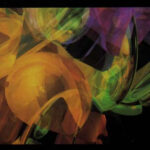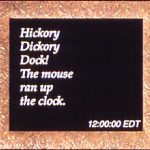Patricia Search: Hickory Dickory Dock: The Clock Strikes One in Hyperspace!
Title:
Artist(s) and People Involved:
Exhibiting Artist(s):
-
Patricia Search
-
- Rensselaer Polytechnic Institute (RPI)
Symposium:
Venue(s):
Artist Statement:
The work on exhibit at ISEA96 is an excerpt from an installation entitled Hickory Dickory Dock which is a critical commentary on the aesthetics of space and time in interactive computing. The installation is a three-dimensional layout of the storyboard for an interactive computer artwork. In the installation twenty-four screen designs are framed and hung back-to-back to create twelve stations that are arranged in a formation resembling the mathematical symbol for infinity. The screen designs are mounted between oversized pieces of Plexiglas, creating transparent borders that visually link the storyboard with the external environment. The installation highlights the conceptual and aesthetic limitations of language and symbols in describing the process of human-computer interaction. The screen designs in the storyboard use language and symbols to show how Western temporal references limit the interpretation of time to specific perspectives and discrete numerical values. These references include answering machine messages; temporal orientation cues such as the days of the week, Recorded Earlier, EDT (Eastern Daylight Time), Now, Earlier, Later; and references to Mother Goose nursery rhymes, a form of early childhood exposure to the use of language to define time. Most screen designs contain a frame in the center that acts as a “window” on time. Some screens also include transparent, three-dimensional (3-D) graphics to remind the viewer of the spatial dimensions of time. The 3-D installation plays an important role in helping the viewer understand the limitations of symbols and language in human-computer interaction. The installation forces the viewer to abandon the interactive conventions (mouse, keyboard, touch screens, etc.) and metaphors that we blindly accept when using the computer. The viewer must translate the commands and symbols in the interface design into movements and actions in the 3-D environment. In this process, the viewer experiences the problems inherent in trying to use visual and linguistic abstractions to define concrete logic. The installation shows how the symbols and language of computer interfaces create perceptual paradoxes that conflict with our cognitive and aesthetic interpretations of space and time in a 3-D environment. These paradoxes are further emphasized by the use of music in the installation. Wireless infrared headphones allow viewers to independently experience low-volume classical music (the Brahms Waltz in A Flat) as they walk through the installation. The holistic qualities of the music contrasts with the fixed frames and measured layout of the installation, emphasizing the dichotomy between discrete mathematical references to time and the ethereal, contiguous representation of time that we experience in 3-D space. However, the semantic structure of music also reinforces the semiotic constraints of the language and symbols in the storyboard, providing a satirical commentary on the prominent role that mathematical measures of time play in a technological society.







